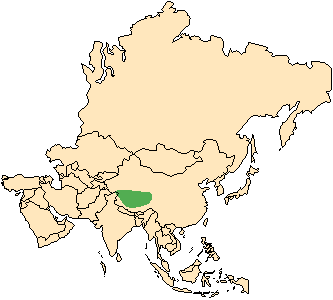![]() Return to
Artiodactyla
Return to
Artiodactyla
Classification
|
 Bos
grunniens
Bos
grunniens
Yak
![]()
Taxonomy
The taxonomic record (above) is taken from Wilson and Reeder (1993). The yak is placed in the subgenus (formerly genus) Poephagus (Nowak, 1991). The name Bos mutus is sometimes used for the the wild yak, but is now considered to be an invalid synonym for B. grunniens (Wilson and Reeder, 1993)
 |
 |
 |
Click on the pictures above for a larger view of the
photographs
|
||
General Characteristics
Body Length: Up to 325 cm / 10.8 ft.
Shoulder Height: Up to 200 cm / 6.6 ft.
Tail Length: 60 cm / 24 in.
Weight: 305-820 kg / 670-1805 lb.The dark black-brown coat is dense, wooly, and extremely shaggy, although the colour is variable in domestic yaks. 'Golden' wild yaks are also known, but are extremely rare. The shoulders are high and humped, with a broad, drooping head. The short legs have broad hooves and large dewclaws as an adaptation to mountainous environments. The horns are found in both sexes, though those of the females are considerably smaller and shorter. They grow up to 51 cm / 20 inches long in females, and 95 cm / 38 inches in males. The curved horns grow out from the sides of the head and curve upwards.
Ontogeny and Reproduction
Gestation Period: 258 days
Young per Birth: 1 every other year.
Weaning: About 1 year.
Sexual Maturity: By 6 years.
Life span: 23 years.The mating season begins in September, lasting for several weeks in which bulls fight each other for females. Young are born in June, the season of plenty in the Tibetan plateau.
Ecology and Behavior
Due to the scarcity of vegetation in their habitat, wild yaks must travel great distances in order to obtain sufficient nourishment. In July, there is a general downward shift from the high plateaus to the lower plains, where mosses and swamp vegetation are at their peak. As the temperature rises in August, the herds head back up to the plateaus, even retiring to snowy regions to beat the heat. Although sensitive to warm temperatures, wild yaks can easily tolerate temperatures of -40o C/F. In severe cold, they have been seen bathing in lakes and streams. Generally distrustful, if a herd is disturbed they will flee for a long distance, galloping with their tails held erect. If something unexpected appears in their flight path, yaks will bluff, attacking with a fast charge and normally stopping just 10-20 meters / 30-60 feet away from the intruder. In spite of their bulky, awkward appearance, yaks are excellent, sure-footed climbers. One of the few vocalizations is a loud grunt, made during the breeding season by wild yaks. Domestic yaks, however, "grunt" throughout the year - hence the specific name grunniens.Family group: Herds of 10-200 individuals consisting of females and young, adult males solitary or in bachelor groups with up to 12 members.
Diet: Lichens, grasses, and tubers.
Main Predators: Tibetan wolf.
Distribution
Montane regions of Tibet at an altitude of 4,000-6,000 m / 12,800-19,200 ft.Countries: China, India, Nepal [regionally extinct?] (IUCN, 2002).

Range Map (Redrawn from Helin et al., 1999)
Conservation Status
The yak is classified as vulnerable (Criteria: A1cd+2cd, C1) by the IUCN (2002). The wild yak, Bos grunniens mutus is listed on CITES Appendix I (CITES, 2003).
Remarks
While there are over 12 million yaks in the world, most of these are domestic. Unfortunately, their wild counterparts are becoming increasingly rare. The yak is one of the most important domesticated beasts in Tibet, where it provides transportation, meat, milk, even its dried dung is used as fuel.
Bos (Latin) an ox. Grunnio (Latin) I grunt, hence grunniens, grunting: yaks are unable to moo.
- French
- Yack (Buchholtz, 1990)
- German
- Yak (Buchholtz, 1990)
Literature Cited
Buchholtz, C. 1990. Cattle. In Grzimek's Encyclopedia of Mammals. Edited by S. P. Parker. New York: McGraw-Hill. Volume 5, pp. 360-417.CITES (Convention on the International Trade in Endangered Species of Wild Flora and Fauna). 2003. Appendix I, as adopted by the Conference of the Parties, valid from 13 February 2003. Available online at http://www.cites.org/eng/append/latest_append.shtml
Helin, S., N. Ohtaishi, and L. Houji. 1999. The Mammalian of China. Beijing: China Forestry Publishing House.
IUCN ( International Union for Conservation of Nature and Natural Resources). 2002. 2002 IUCN Red List of Threatened Species. Available online at http://www.redlist.org
Nowak, R. M. [editor]. 1991. Walker's Mammals of the World (Fifth Edition). Baltimore: The Johns Hopkins University Press.
Wilson, D. E., and D. M. Reeder [editors]. 1993. Mammal Species of the World (Second Edition). Washington: Smithsonian Institution Press. Available online at http://nmnhwww.si.edu/msw/
Additional Resources
Boitani, L., and S. Bartoli. 1982. Simon & Schuster's Guide to Mammals. New York: Fireside/Simon & Schuster, Inc. Entry 385.Harris, R.B., D. H. Pletshcer, C. O. Loggers, and D. J. Miller. 1999. Status and trends of Tibetan plateau mammalian fauna, Yeniugou, China. Biological Conservation 87: 13-19.
Miller, D. J., and G. B. Schaller. 1997. Conservation threats to the Chang Tang Wildlife Reserve, Tibet. Ambio 26(3): 185-186.
Miller, D. J., R. Harris, and G. Cai. 1994. Wild yaks and their conservation on the Tibetan Plateau. In Proceedings of the 1st International Congress on Yak. Edited by R. Zhang, J. Han, and J. Wu. Gansu Agricultural University, Lanzhou. pp. 27-34.
Schaller, G.B. and Gu, B. (1994) Ungulates in Northwest Tibet. National Geographic Research and Exploration 10(3): 266-293.
Schaller, G.B. and Wulin, L. (1996) Distribution, status, and conservation of wild yak (Bos grunniens). Biological Conservation 76(1): 1-8.
Return to Artiodactyla

![]()
© Brent Huffman, www.ultimateungulate.com |
|
|